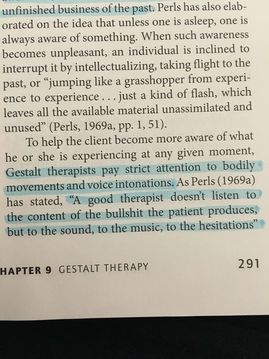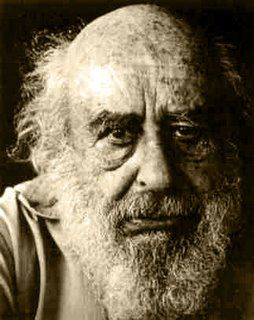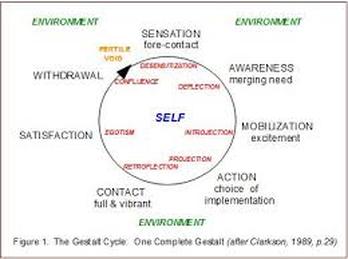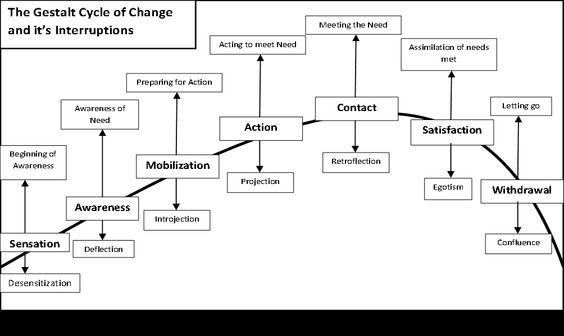 http://gestalttherapysydney.com/about-gestalt
http://gestalttherapysydney.com/about-gestalt
Ways of Being:
The role of the counselor is active by challenging and directing the client. Help bring awareness to the client of their life patterns and needs. The counselor provides a safe environment for the client to explore the field. The therapy focuses on self-regulation and self-actualization by viewing the client holistically. The counselor is encouraging, actively listens, and pays close attention to body language.
The role of the counselor is active by challenging and directing the client. Help bring awareness to the client of their life patterns and needs. The counselor provides a safe environment for the client to explore the field. The therapy focuses on self-regulation and self-actualization by viewing the client holistically. The counselor is encouraging, actively listens, and pays close attention to body language.
 thecowgills.blogspot.com
thecowgills.blogspot.com
The role of the client must fully accept their-self fully both the good and bad. Through involvement and honesty client gains awareness of their needs and environment.
The role of the therapeutic relationship is collaborative and explore as two experts. The client and counselor has an interconnection and rely on one another. The relationship is in the here and now and it is an I-Thou relationship.
The role of the therapeutic relationship is collaborative and explore as two experts. The client and counselor has an interconnection and rely on one another. The relationship is in the here and now and it is an I-Thou relationship.
 velveteenbun.tumblr.com
velveteenbun.tumblr.com
Way of Understanding:
The view of human nature is based on holism, the counselor views the person as a whole both the mind and body. Gestalt therapy is anti-deterministic and believes people seek to be whole and productive. With the gain of self-actualization clients then become responsible and self-regulate; naturally people avoid responsibility. Perls believe that the client brings the past, present, and future in the here-and-now and one distance their-self by using then and there. The focus is on the client's interpretation of the situation. The counselor emphasizes the on the process of using what and how. Also, the body expresses repression through movement and posture, the counselor actively comments on body language throughout the sessions.
View of the problem/maladaptive behavior is when a need is not met or met with toxicity. When a need is not meet it become unfinished business. Unfinished business and/or the past will cause clients to be irresponsible and childish a resistance to contact. "Psychopathology occurs when natural processes of contact, excitement, self-regulation, and new learning are disturbed" (Sommers-Flanagan, 200). When a contact is challenging the client is resistant to facing the contact or bring it to awareness(figure). When a need is not met it is meet with a boundary disturbance, it is similar to a defense mechanism. There are five boundary disturbances: (1) Introjection is the acceptance of other's beliefs without examination.(2) Projection is the project of traits onto others. (3) Retroflection is "when someone turns back on him/herself something s/he would like to do to another person. [or] It involves the doing to ourselves what we would like someone in the environment to do to or for us" (Sommers-Flanagan, 201). (4) Deflection is a distraction and/or avoidance of the contact. (5) Confluence is the merging of boundaries.
View of healthy/adaptive behavior "in the Gestalt world is characterized by contact, full awareness, full sensory functioning, and spontaneity" (Sommers-Flanagan, 200). The client is in the moment and is being true to oneself. The clients is able to recognize their need and is able to meet their need through managing the environment.
Goals of theory is for the client to gain self-awareness and to be in the moment of here-and-now. Past unfinished business is resolved and the client is able to base actions on the present moment. The client takes responsibility for their actions and for their needs. The client is able to meet their needs without invading others.
Key concepts of Gestalt therapy: Self-regulation is obtained through self-actualization. The goal of self-regulation is to graceful move through the process to reach equilibrium again through awareness of a need and taking action by making contact to get the need meet. Holism is "A primary idea associated with Gestalt is that "the whole is different or greater than the sum of its parts" (Sommers-Flanagan, 195). Field Theory is the interaction between an individual and the environment. The figure-formation process is how one perceives their environment through shifts in awareness. There is always some awareness of the background. "The primary or dominant needs of an individual can emerge from the background (ground) into focus (figure) at any given moment" (Sommers-Flanagan, 198).
View of therapeutic change: It the client gains self-awareness and regulation through phases. First, it the dialogic relationship building communication and authenticity. Second, awareness, becoming aware on emotions and body sensations. Body feedback, the counselors observe non-verbals and point them out to the clients to help them gain self-awareness and control over their bodies. Counselors also pay close attention to language and voice quality, it describes who they are and their experience. Then bringing unfinished business into the here-and-now. The third phase it the experiments(techniques).
The view of human nature is based on holism, the counselor views the person as a whole both the mind and body. Gestalt therapy is anti-deterministic and believes people seek to be whole and productive. With the gain of self-actualization clients then become responsible and self-regulate; naturally people avoid responsibility. Perls believe that the client brings the past, present, and future in the here-and-now and one distance their-self by using then and there. The focus is on the client's interpretation of the situation. The counselor emphasizes the on the process of using what and how. Also, the body expresses repression through movement and posture, the counselor actively comments on body language throughout the sessions.
View of the problem/maladaptive behavior is when a need is not met or met with toxicity. When a need is not meet it become unfinished business. Unfinished business and/or the past will cause clients to be irresponsible and childish a resistance to contact. "Psychopathology occurs when natural processes of contact, excitement, self-regulation, and new learning are disturbed" (Sommers-Flanagan, 200). When a contact is challenging the client is resistant to facing the contact or bring it to awareness(figure). When a need is not met it is meet with a boundary disturbance, it is similar to a defense mechanism. There are five boundary disturbances: (1) Introjection is the acceptance of other's beliefs without examination.(2) Projection is the project of traits onto others. (3) Retroflection is "when someone turns back on him/herself something s/he would like to do to another person. [or] It involves the doing to ourselves what we would like someone in the environment to do to or for us" (Sommers-Flanagan, 201). (4) Deflection is a distraction and/or avoidance of the contact. (5) Confluence is the merging of boundaries.
View of healthy/adaptive behavior "in the Gestalt world is characterized by contact, full awareness, full sensory functioning, and spontaneity" (Sommers-Flanagan, 200). The client is in the moment and is being true to oneself. The clients is able to recognize their need and is able to meet their need through managing the environment.
Goals of theory is for the client to gain self-awareness and to be in the moment of here-and-now. Past unfinished business is resolved and the client is able to base actions on the present moment. The client takes responsibility for their actions and for their needs. The client is able to meet their needs without invading others.
Key concepts of Gestalt therapy: Self-regulation is obtained through self-actualization. The goal of self-regulation is to graceful move through the process to reach equilibrium again through awareness of a need and taking action by making contact to get the need meet. Holism is "A primary idea associated with Gestalt is that "the whole is different or greater than the sum of its parts" (Sommers-Flanagan, 195). Field Theory is the interaction between an individual and the environment. The figure-formation process is how one perceives their environment through shifts in awareness. There is always some awareness of the background. "The primary or dominant needs of an individual can emerge from the background (ground) into focus (figure) at any given moment" (Sommers-Flanagan, 198).
View of therapeutic change: It the client gains self-awareness and regulation through phases. First, it the dialogic relationship building communication and authenticity. Second, awareness, becoming aware on emotions and body sensations. Body feedback, the counselors observe non-verbals and point them out to the clients to help them gain self-awareness and control over their bodies. Counselors also pay close attention to language and voice quality, it describes who they are and their experience. Then bringing unfinished business into the here-and-now. The third phase it the experiments(techniques).
 https://s-media-cache-ak0.pinimg.com/originals/
https://s-media-cache-ak0.pinimg.com/originals/
Ways of Intervening:
Techniques or Experiments: Staying with the feeling- encourages the client to stay with their feeling through asking them about the client's awareness, instructing the client to give a voice to their feeling, and encouraging the client to act out their feeling. This experiment improves awareness and sometime an "Ah ha" moment.
I Take Responsibility For...-encouraging the client take responsibility for their feelings and actions.
Playing the projection-mostly used in group therapy. " When Perls observed a group member making a statement about someone else that seemed to have much more to do with herself, Perls would ask the participant to play the projection." (Sommers-Flanagan, 209). The client would act out the feeling he/she was having about the other person.
The Reversal Technique- Clients are encourage to act in behaviors that are less prominent, for example it the client is passive he/she would act aggressively. This technique is to get clients in touch with their whole self and to become aware to their thoughts, feelings, and sensations while using this technique.
The Exaggeration Experiment- Clients are encouraged to exaggerate nonverbal body language. This brings awareness to the clients and help them take back control over their body. This also helps point out if the behavior is a pattern or not.
The Empty-Chair Technique- 1) Resolving internal conflicts- the client switches from chair to chair playing as two different parts of themselves. 2) Resolving interpersonal conflicts- Dialogue is on an old conflict or contemporary interpersonal conflict. The client stays in one chair, but acts out both dialogue. "The focus is entirely on monitoring, reflecting, and coming to terms with the client's emotional experiences" (Sommers-Flanagan, 212).
Dream work- There are four steps: 1) Client tells the dream. 2) The client states it in present tense to revive the dream. 3) The client is the director of the dream. 4) The client acts out the dream. The goal of this technique is for the client to gain awareness and holism by re-connecting with parts of their personality from the dreams.
Multicultural considerations: Gestalt therapy could deepen cultural awareness and allow the client to live more authentically. This therapy may not align with collectivist cultural or cultural with restrictions on emotions. This therapy might work better for women than men due to cultural expectations of women being more comfortable with emotion focused therapy. Also, the therapy have a few publications on working with GLBT issues and concerns.
Working with individuals: Gestalt therapy would best be implicated with individuals because it focuses on the emotion and needs of that person.
Limitations: Gestalt therapy has limited evidence-based studies and are unable to verify the theory. "Perls was generally against therapy outcome studies and nomothetic approaches to understanding the individual. He emphasizes that discovering what works should not and cannot be determined through research. Most effective with reserved, internalizing clients" (Sommers-Flanagan, 219).
Techniques or Experiments: Staying with the feeling- encourages the client to stay with their feeling through asking them about the client's awareness, instructing the client to give a voice to their feeling, and encouraging the client to act out their feeling. This experiment improves awareness and sometime an "Ah ha" moment.
I Take Responsibility For...-encouraging the client take responsibility for their feelings and actions.
Playing the projection-mostly used in group therapy. " When Perls observed a group member making a statement about someone else that seemed to have much more to do with herself, Perls would ask the participant to play the projection." (Sommers-Flanagan, 209). The client would act out the feeling he/she was having about the other person.
The Reversal Technique- Clients are encourage to act in behaviors that are less prominent, for example it the client is passive he/she would act aggressively. This technique is to get clients in touch with their whole self and to become aware to their thoughts, feelings, and sensations while using this technique.
The Exaggeration Experiment- Clients are encouraged to exaggerate nonverbal body language. This brings awareness to the clients and help them take back control over their body. This also helps point out if the behavior is a pattern or not.
The Empty-Chair Technique- 1) Resolving internal conflicts- the client switches from chair to chair playing as two different parts of themselves. 2) Resolving interpersonal conflicts- Dialogue is on an old conflict or contemporary interpersonal conflict. The client stays in one chair, but acts out both dialogue. "The focus is entirely on monitoring, reflecting, and coming to terms with the client's emotional experiences" (Sommers-Flanagan, 212).
Dream work- There are four steps: 1) Client tells the dream. 2) The client states it in present tense to revive the dream. 3) The client is the director of the dream. 4) The client acts out the dream. The goal of this technique is for the client to gain awareness and holism by re-connecting with parts of their personality from the dreams.
Multicultural considerations: Gestalt therapy could deepen cultural awareness and allow the client to live more authentically. This therapy may not align with collectivist cultural or cultural with restrictions on emotions. This therapy might work better for women than men due to cultural expectations of women being more comfortable with emotion focused therapy. Also, the therapy have a few publications on working with GLBT issues and concerns.
Working with individuals: Gestalt therapy would best be implicated with individuals because it focuses on the emotion and needs of that person.
Limitations: Gestalt therapy has limited evidence-based studies and are unable to verify the theory. "Perls was generally against therapy outcome studies and nomothetic approaches to understanding the individual. He emphasizes that discovering what works should not and cannot be determined through research. Most effective with reserved, internalizing clients" (Sommers-Flanagan, 219).




